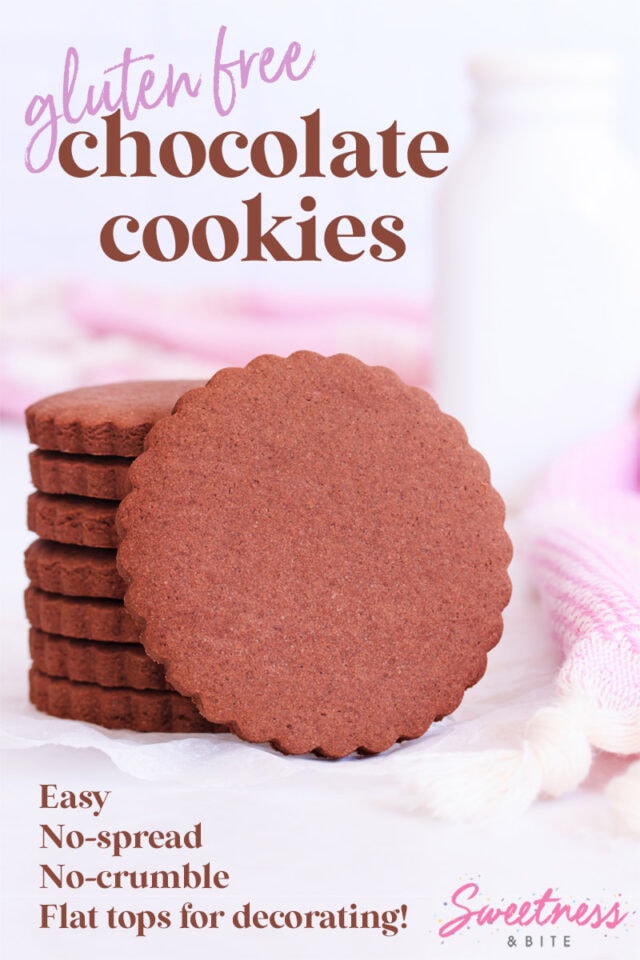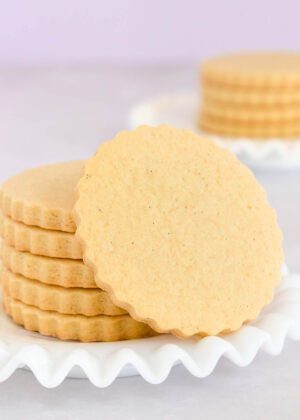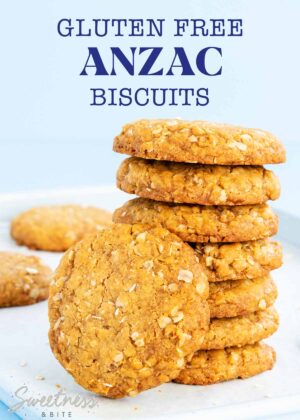Gluten Free Chocolate Cookies
This post may contain affiliate links to products I recommend. I receive a small commission at no cost to you if you make a purchase using my link.
These gluten free chocolate cookies are crunchy, with a deep chocolate flavour. They’re the best gluten free chocolate cut-out cookie, because they hold their shape and have smooth, flat tops that are perfect for decorating.
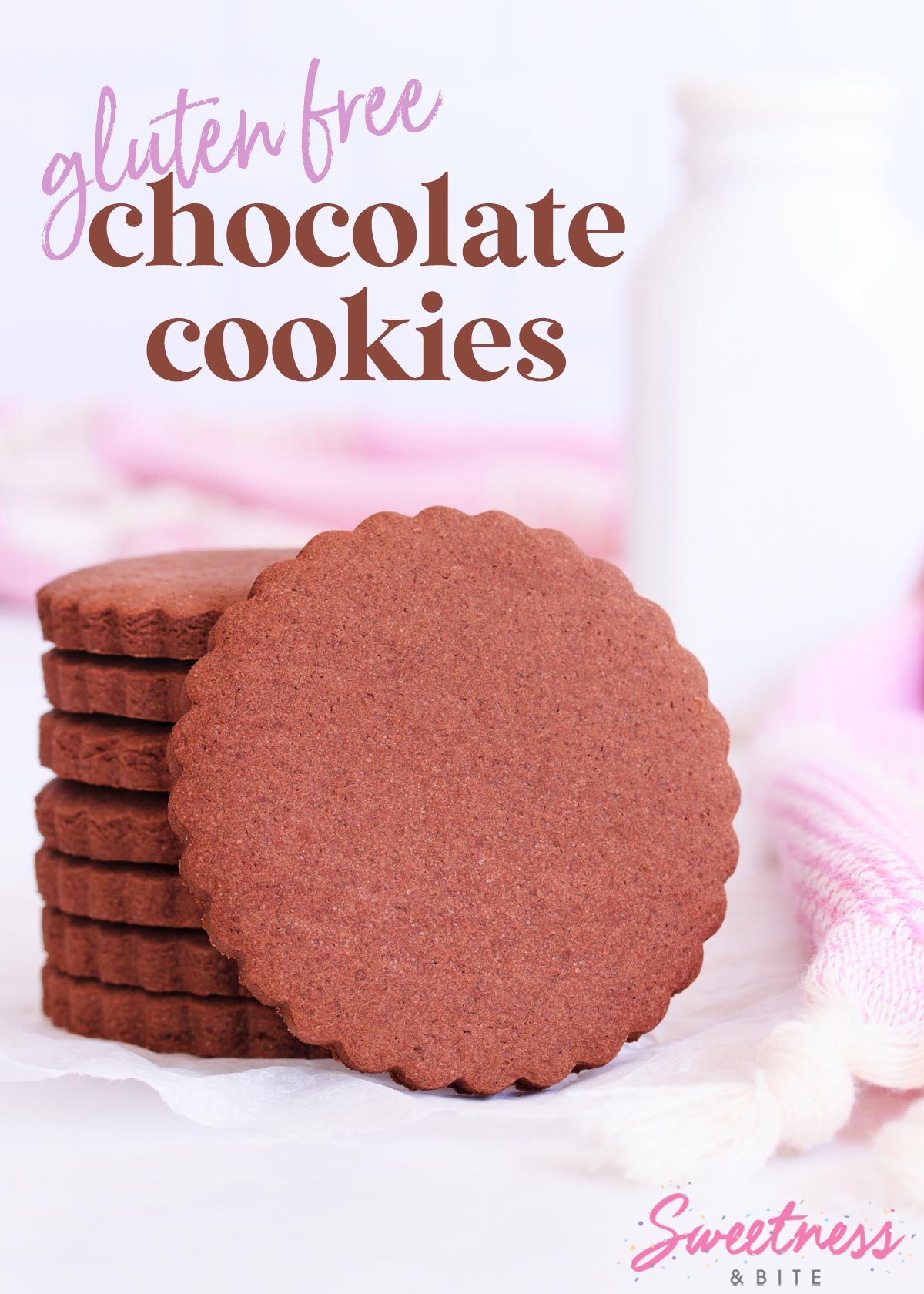
If you’re on the search for the best gluten-free chocolate cookie recipe, then I am here to tell you that these cookies are the ones you’ve been waiting for.
Well, they’re definitely the ones I’ve been waiting for. Maybe you have been too.
This gluten free chocolate cookie recipe is everything I love about my gluten free vanilla sugar cookie recipe that I spent several weeks perfecting in 2020, but with super rich chocolate flavour.
And just like the vanilla ones, these cookies don’t break easily, making them the best gluten-free chocolate cookies to decorate with royal icing or fondant (or really any way you want to decorate them).
Ingredients
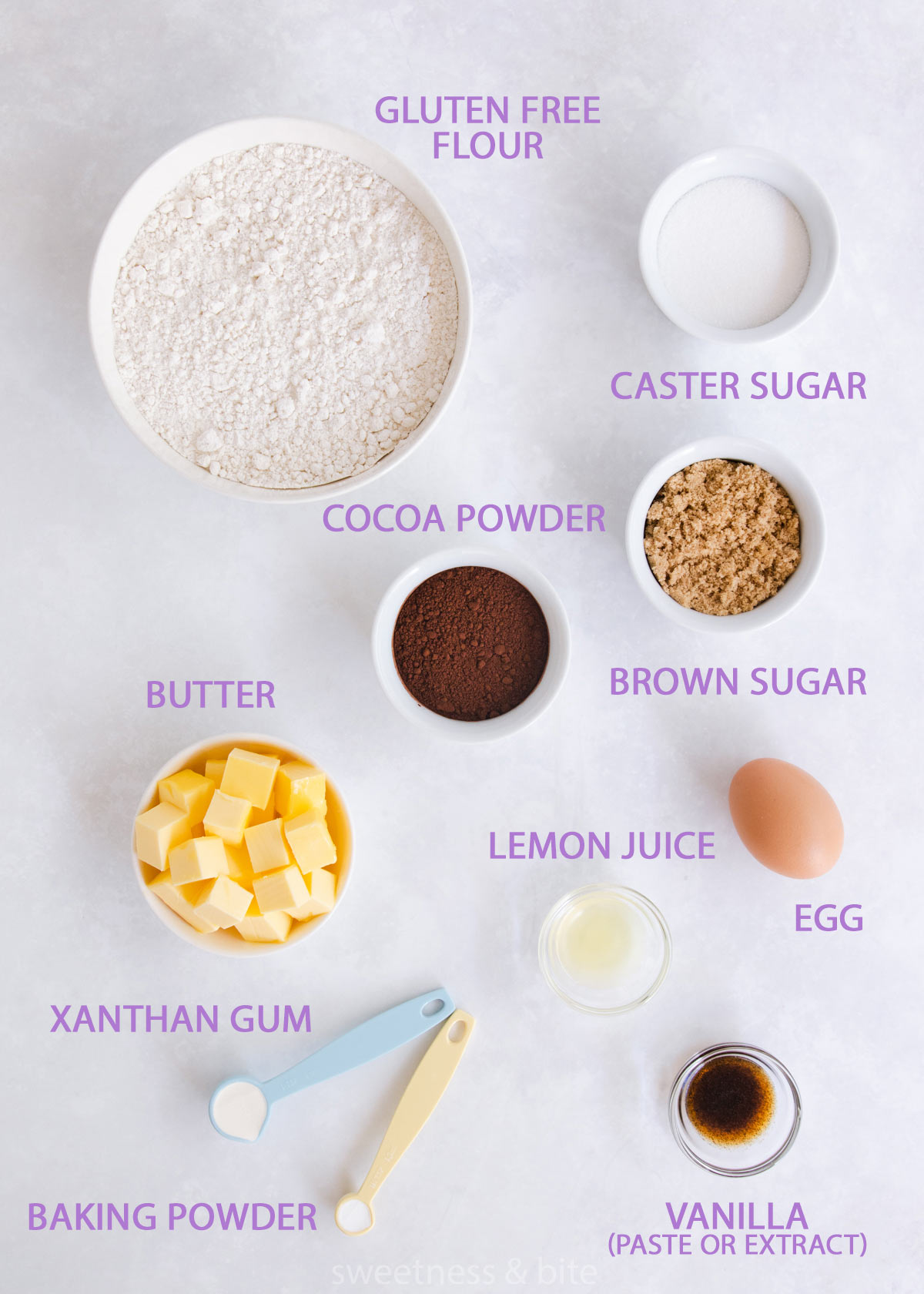
Gluten free flour – I used my favourite homemade gluten free baking flour blend. If you use a different homemade or storebought gluten free all purpose flour blend, keep in mind that your results may vary from mine, due to the different gf flours and proportions used in different blends.
Cocoa powder – I used Dutch-processed cocoa powder, as it gives the best dark chocolate flavour.
Xanthan gum – This helps the dough bind together and stops the cookies from crumbling. If using a prepared gluten free flour blend that contains a gum ingredient, then you can omit the xanthan gum from the recipe.
Baking powder – Make sure your baking powder is gluten free.
Caster sugar – Caster sugar helps keep the smooth surface on the cookie, but if you only have regular granulated sugar on hand, then use that instead.
Brown sugar – The brown sugar in this recipe serves three purposes – it gives extra flavour and extra moisture, and it also adds extra acidity to help the cookies keep their shape (more on that below).
Butter – You can use either salted or unsalted butter in this recipe.
Egg – You’ll need one large (size 7, in NZ) egg.
Vanilla – Either vanilla paste or pure vanilla extract will work in this recipe.
Lemon juice – This is the magic ingredient that stops these cookies from spreading. Adding extra acid to the dough makes the cookies set quicker in the oven, which means they don’t have a chance to spread. Don’t worry, you do not taste the lemon in this recipe (just as well, I don’t like chocolate and lemon together), it’s just there to provide the acidity and help the cookies keep their shape.
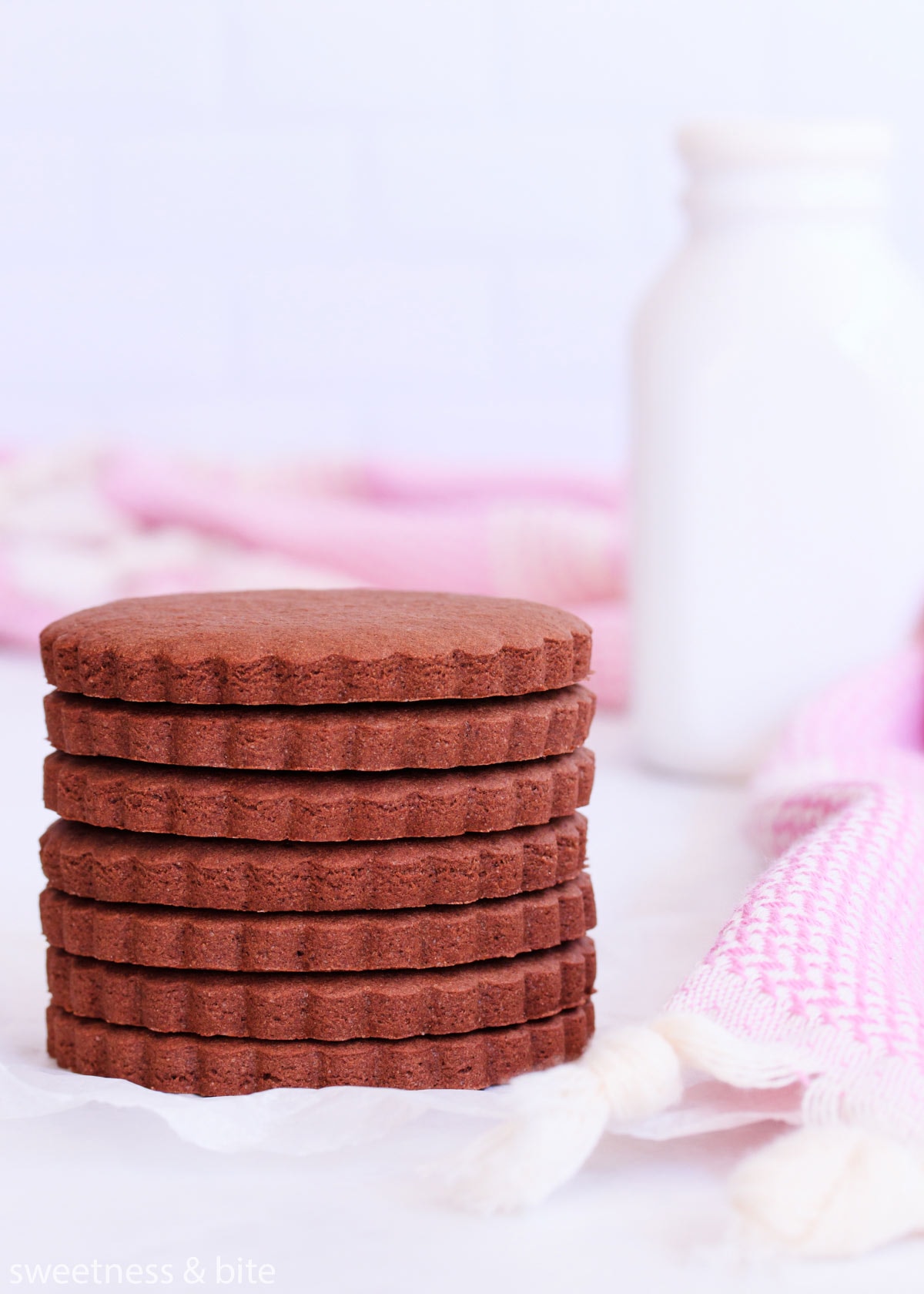
How to Make Gluten Free Chocolate Cookies
This is a super easy recipe to make. You can either use a stand mixer to make the dough or use a handheld electric mixer and a large bowl.
You’ll start by sifting the dry ingredients together into a medium bowl and giving them a good whisk to combine them well.
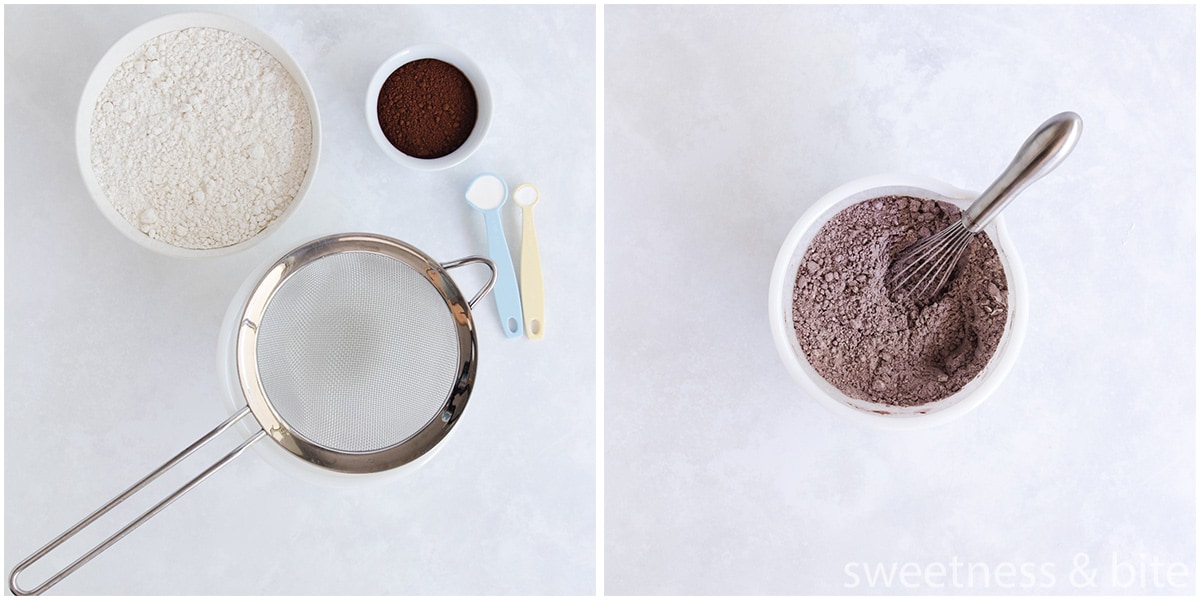
The butter, both sugars and vanilla get beaten at medium speed just until it looks creamy. This is one time when we don’t want to beat it until it’s fluffy – fluffy means air bubbles, air bubbles mean the cookies will rise and be lumpy on the top.
Then the egg gets beaten in, again just until it’s combined (if it separates a bit, don’t panic, it will come back together in the next step).
Next, mix the dry ingredients in, in 2-3 additions. If you’re using a hand mixer, you might want to mix the last addition of flour in by hand with a wooden spoon, as the dough will get quite thick and it may be too difficult for the mixer.
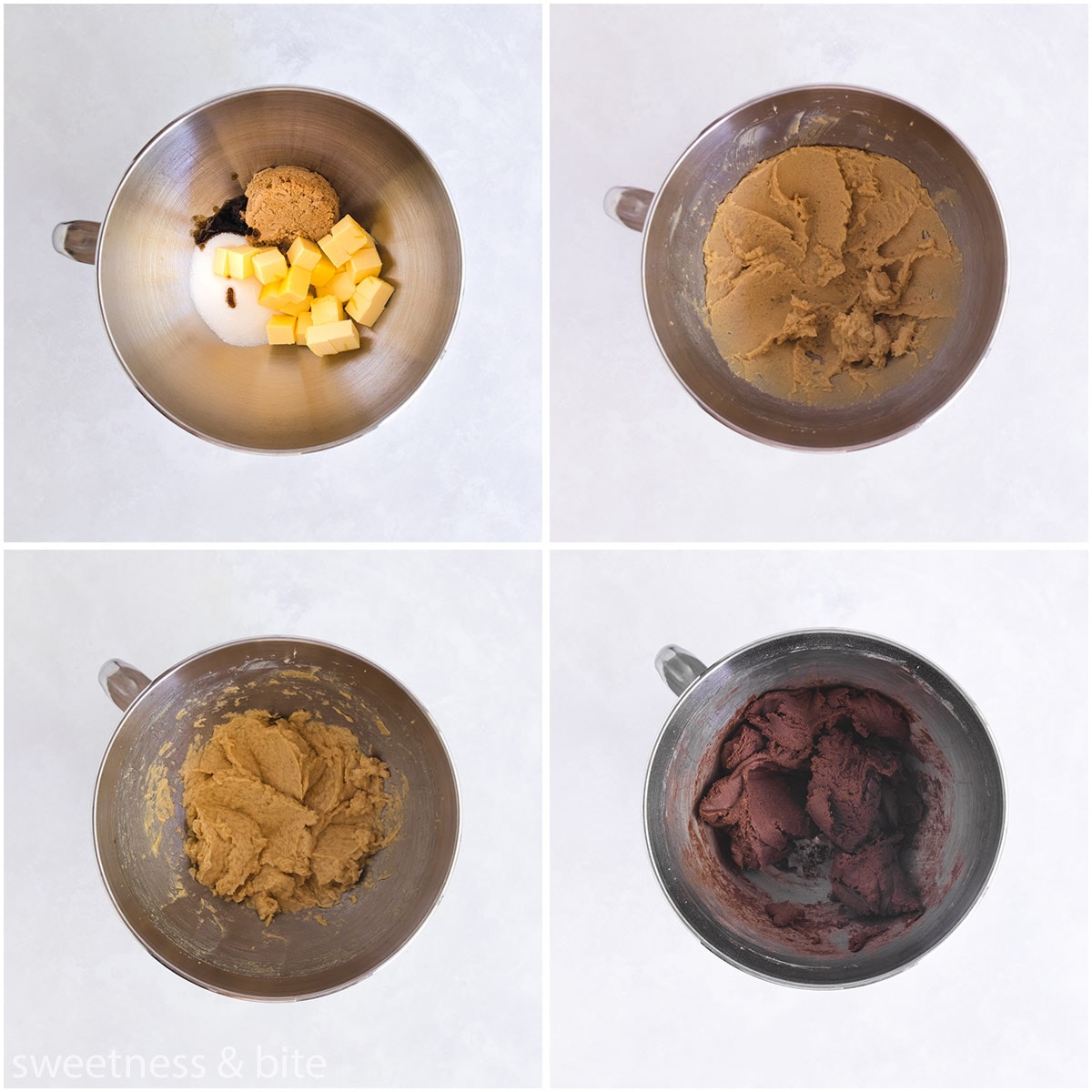
At this stage, the dough may be slightly soft. Pop the whole bowl of dough into the fridge for 5-10 minutes while you tidy the bench. Then it should be ready to roll out.
Split the dough into two, and roll out each piece on a piece of non-stick baking paper or parchment. Use a light dusting of gluten free flour or cornstarch (I just use cornstarch in a shaker) if needed to stop the dough sticking to the rolling pin.
For an even thickness, I use pieces of 5mm thick dowel on either side of the dough. Rolling pins with spacer rings are also perfect for this.
Slide the rolled out dough onto a baking sheet and refrigerate it until it’s firm.
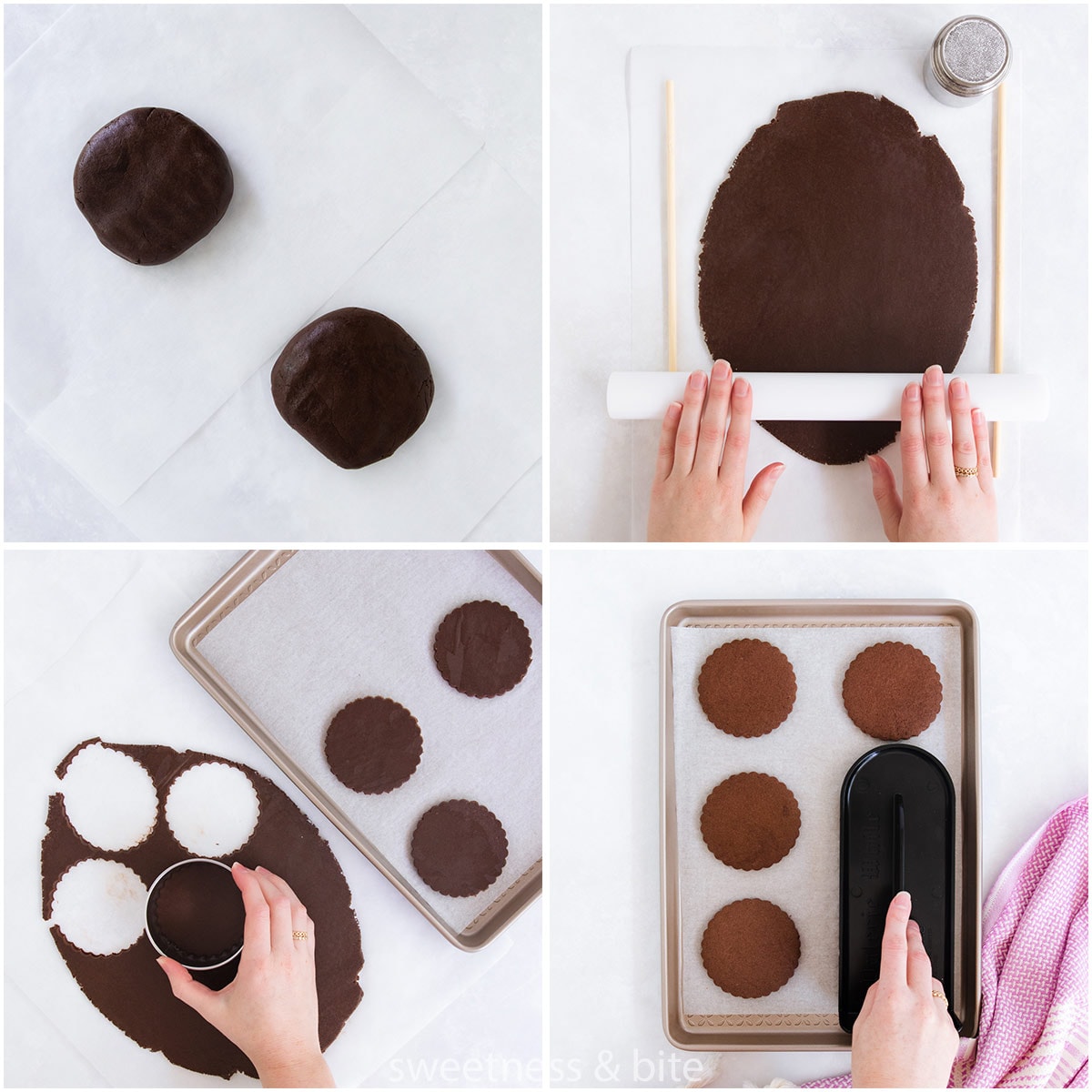
Cut out your cookie shapes and place them onto prepared baking sheets. Chill the shapes again just until they’re firm.
The excess dough can be re-rolled as many times as necessary – because there is no gluten to overwork, re-rolling the dough doesn’t make the subsequent cookies tough.
Baking the Cookies
The exact bake time for the cookies will vary based on a few things:
The size of your cookies – Bigger cookies will need to bake for a longer time than smaller ones.
The shape of your cookies – If the cookie cutter has smaller, more detailed/finer areas, those parts will brown faster than the rest of the cookie. Check them regularly during the last few minutes of baking to make sure those parts don’t brown too much.
How thick you roll the dough – I like to roll the dough to about 5mm thick. If you roll it thicker or thinner, you will need to adjust your baking time.
Your oven – I bake the cookies on regular bake, which in our oven has heat coming from the top and bottom elements and no fan. If your oven heats differently or has a fan setting that you can’t turn off, you may need to play around with the temperature setting and baking time to figure out what works best for you.
Your cookie sheets – The thickness and colour of your baking sheets will also affect how quickly they bake. Darker metal will brown the cookies faster than lighter metal. Thicker baking sheets will be less likely to warp in the oven and leave you with misshapen cookies.
I give you some rough timings for small, medium and large cookies in the recipe card below, but use those as guides, test the temperature and timing with your first tray of cookies, and adjust from there. It can be good to bake a tray with just a few “sacrificial” cookies first.
Let the cookies cool on the tray and firm up slightly before transferring them to a wire rack to cool.
As pictured in the bottom left photo in the collage above, for super flat cookies you can gently press the tops with a fondant smoother or other flat object) as soon as they come out of the oven. This will flatten any little lumps and bumps, and make the surface smoother for icing with fondant or royal icing.
Speaking of…
Decorating the Cookies
My favourite thing about these cookies is how great they are to decorate. You can pretty much decorate these however you like.
They’re very sturdy, so if you’re decorating them with fondant or royal icing, you can easily move them around to decorate without them falling apart.
I wasn’t in the mood to decorate these ones, so I simply drizzled them with some melted dark chocolate and sprinkled on some chocolate sprinkles. Milk chocolate would be great on these too, and white chocolate would give a lovely contrast.
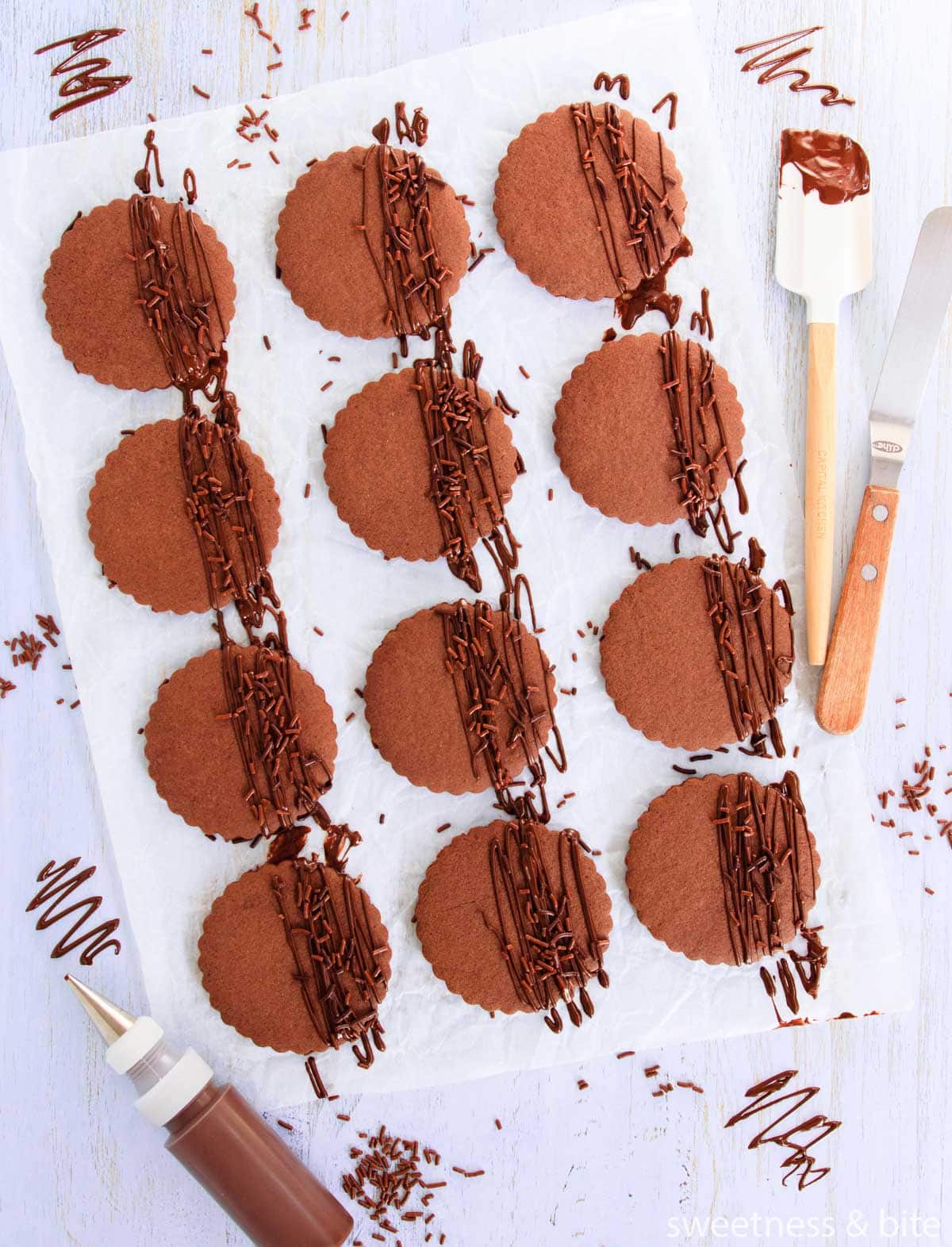
Storing the Cookies
How you store the cookies will depend on how you have decorated them. Cookies with royal icing can be stored in airtight containers (place sheets of baking paper or parchment between the layers of cookies) or can be sealed in cellophane bags to keep them fresh. They will keep like that for 1-2 weeks, at least.
Fondant iced cookies shouldn’t be stored airtight, as if there is any moisture left, the fondant can absorb it and become sticky. They’re best decorated close to serving – I usually do them 1-2 days before serving, at most.
Un-iced cookies can be stored in an airtight container for 1-2 weeks. They will soften over time, if you want the crispy edges back, pop them into a warm oven for a few minutes.
Freezing Gluten Free Chocolate Cookie Dough
The best way to get a head-start on cookie making is to make the dough in advance and freeze it.
Once you’ve made the dough, split it into two balls, flatten the balls into discs, then wrap them well with plastic wrap and place them into an airtight container or sealable plastic bag. On the day you want to bake the cookies, take the dough out of the freezer an hour or two before you want to roll it.
You can also freeze the cut-out cookie dough shapes. Cut them out, then place in a single layer onto a baking sheet and freeze them until firm. Then stack them into an airtight container, placing pieces of baking paper or parchment between each layer so they don’t stick together. No need to thaw the shapes before baking, just add an extra minute or two to the baking time.

Gluten Free Cookie Making Tips
- Make sure you start with your ingredients at room temperature, especially the butter and eggs. To soften butter faster, cut it into cubes, pop it on a microwave safe plate or bowl, and microwave in short bursts on low power/defrost until just softened. To warm eggs up faster, place them in their shell into a bowl of hot tap water, and leave them there while you prepare the other ingredients.
- For the best cookies, it really is important to use a good quality gluten-free flour blend. The type of flours and starches used in a blend can (literally) make or break your gluten-free cookies. Purchased flour blends vary a lot between brands, and brands vary between countries. I always recommend my homemade gluten free baking flour blend, which contains tapioca starch, potato starch and brown rice flour. I find it so reliable, it’s the blend I test all my recipes with, and it can be replicated in any country where those flours and starches can be purchased.
- Try not to use much extra flour when rolling out the dough – this can make the cookies dry. Roll the dough out on a piece of non-stick baking paper or parchment paper, and just use a very light dusting of flour on top of the dough as needed to stop it sticking to the rolling pin.
- Don’t skip the chilling. Chilling the rolled out dough makes it much easier to cut out the shapes and transfer them to the baking sheet without distorting them. Chilling the cut out shapes helps them keep their shape in the oven as they bake.
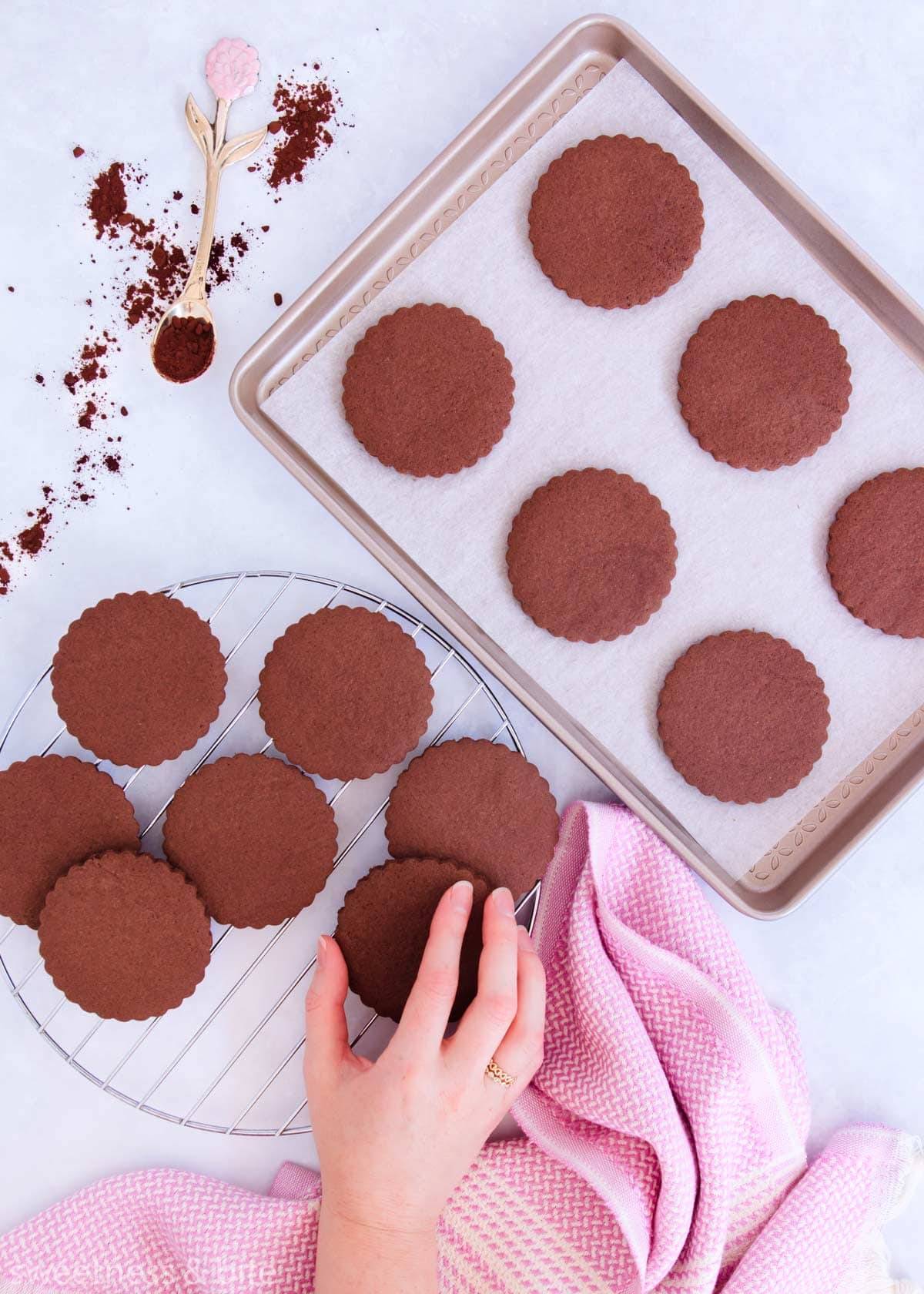
Q&A
So far I have only tested this recipe with Dutch-processed cocoa, as currently it’s the only kind I can buy at our local supermarket (but aside from that it’s also my favourite to use for the most delicious flavour!). Dutch cocoa is processed to give it a darker colour and less bitter taste. It is also less acidic than regular cocoa.
You should be able to substitute the Dutch cocoa in this recipe with regular cocoa powder (unsweetened cocoa powder). The colour will be slightly lighter, and the chocolate flavour won’t be quite as strong.
Yes, if you need to make a lot of cookies, you can double, triple, quadruple it… whatever you can fit in your stand mixer or mixing bowl.
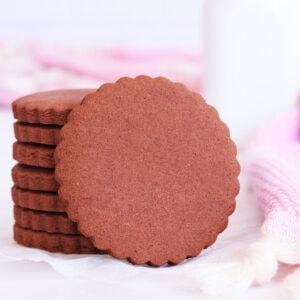
Gluten Free Chocolate Cookies
Ingredients
- 290 g gluten free flour
- 40 g Dutch cocoa powder
- 1 teaspoon xanthan gum*
- ¼ teaspoon baking powder
- 125 g butter softened
- 75 g caster sugar
- 75 g brown sugar
- 2 teaspoons vanilla extract or paste
- 1 ½ teaspoons lemon juice
- 1 large egg at room temperature
Instructions
- Sift together the gluten free flour, cocoa powder, xanthan gum and baking powder. Whisk to combine well and set aside.
- Using a stand mixer with the paddle attachment, or an electric handheld mixer and a large bowl, beat together the butter, caster sugar, brown sugar, vanilla and lemon juice just until creamy and combined. We don't want to add too much air – that will cause bubbles and an uneven surface on the cookies.
- Add in the egg, and mix again until combined. Don't worry if the mixture separates.
- Add the dry ingredients in 2-3 additions. (If using a hand mixer, you might want to mix the last addition of flour in by hand with a wooden spoon, as the dough will get quite thick and it may be too difficult for the mixer.) Scrape down the sides of the bowl, and mix again until well combined and a soft dough has formed.
- Pop the bowl into the fridge for 10-15 minutes, until the dough firms up slightly. I use this time to clean the bench and get everything ready to roll the dough out.
- Split the dough into two, and roll out each piece on a piece of non-stick baking paper or parchment. Use a light dusting of gluten-free flour or cornstarch (I just use cornstarch in a shaker) if needed to stop the dough from sticking to the rolling pin. The dough should be approximately 5mm thick (see notes below for tips). Once rolled, place another piece of baking paper on top, slide the dough onto a baking sheet and refrigerate until firm. Repeat with the other ball of dough.
- When ready to bake, heat the oven to 180°C (approx. 350°F) and line baking sheets with non-stick baking paper.
- Flip the piece of dough over, and gently peel the back piece of baking paper off the dough, then press it back down lightly (this makes it easier to pick up the shapes when you cut them as the dough is not stuck to the paper) then flip the dough back over and peel off the top piece of paper.
- Cut out the dough using your chosen cookie cutters, and place the shapes onto baking sheets, about 1" apart. If the shapes are still firm and cold, you can bake them immediately, if they have softened then pop them back in the fridge for a few minutes to firm back up.
- Bake the cookies for 10-14 minutes, depending on size. As a rough guide: 10 min for small cookies, 12 min for medium cookies and 14 min for large cookies. Check the first tray after 10 minutes, and adjust the baking time from there.
- Allow cookies to cool slightly on the trays until firm enough to handle, then carefully move them to a wire rack to cool completely.
- Store in an airtight container and/or decorate as desired. They will keep well for at least a week, although they will naturally soften over time.
To freeze the cookie dough:
- Once you've finished mixing the dough, shape it into a flat square shape (or two), wrap well in plastic wrap and seal in an airtight container or resealable plastic bag. Thaw the dough before rolling.
- You can also freeze the cut out dough shapes before baking them. Place the shapes in a single layer onto a baking sheet and freeze them until firm. Stack them into an airtight container, placing sheets of baking paper or parchment between each layer so they don’t stick together. No need to thaw the shapes before baking, just add an extra minute or two to the baking time.
Notes
Nutrition
Nutritional Disclaimer: Any nutritional information provided is a computer generated estimate and is intended as a guide only.

